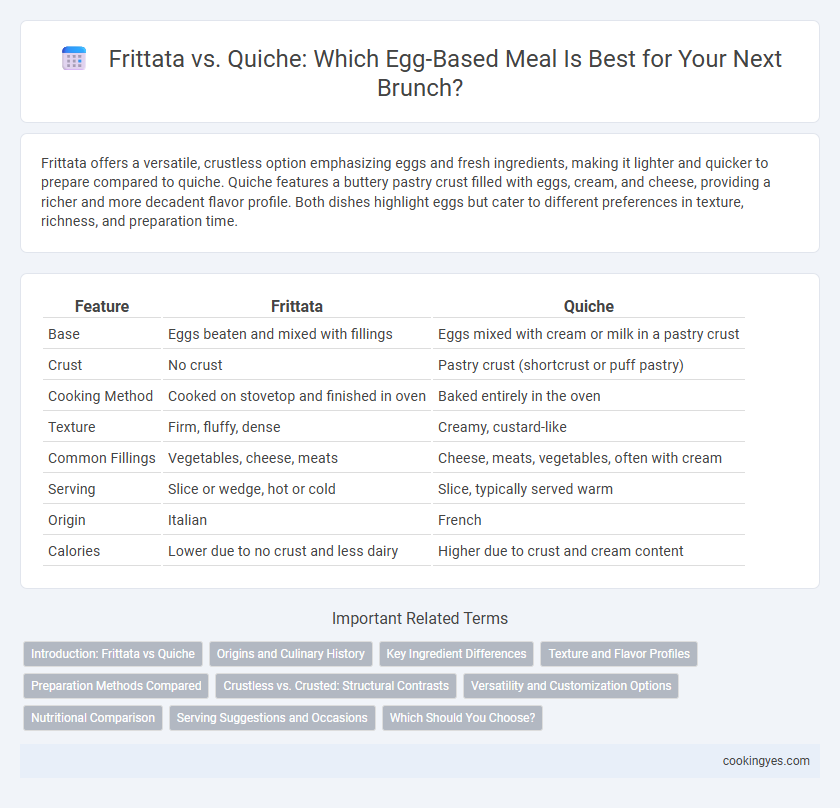Frittata offers a versatile, crustless option emphasizing eggs and fresh ingredients, making it lighter and quicker to prepare compared to quiche. Quiche features a buttery pastry crust filled with eggs, cream, and cheese, providing a richer and more decadent flavor profile. Both dishes highlight eggs but cater to different preferences in texture, richness, and preparation time.
Table of Comparison
| Feature | Frittata | Quiche |
|---|---|---|
| Base | Eggs beaten and mixed with fillings | Eggs mixed with cream or milk in a pastry crust |
| Crust | No crust | Pastry crust (shortcrust or puff pastry) |
| Cooking Method | Cooked on stovetop and finished in oven | Baked entirely in the oven |
| Texture | Firm, fluffy, dense | Creamy, custard-like |
| Common Fillings | Vegetables, cheese, meats | Cheese, meats, vegetables, often with cream |
| Serving | Slice or wedge, hot or cold | Slice, typically served warm |
| Origin | Italian | French |
| Calories | Lower due to no crust and less dairy | Higher due to crust and cream content |
Introduction: Frittata vs Quiche
Frittata and quiche are popular egg-based dishes that offer distinct textures and flavors for breakfast or brunch. Frittata is an Italian-style open-faced omelette cooked slowly without a crust, emphasizing a fluffy interior with mixed vegetables, cheese, or meat. Quiche features a rich, buttery pastry crust filled with a custard mixture of eggs, cream, and various ingredients baked until set, delivering a creamy and savory experience.
Origins and Culinary History
Frittata, originating from Italian cuisine, dates back to ancient Roman times as a simple, versatile egg-based dish often cooked on the stovetop. Quiche, with roots in medieval German and French Lorraine regions, is distinguished by its flaky pastry crust and custard-like filling, evolving into a savory tart by the 16th century. Both dishes reflect regional agricultural practices and ingredient availability, with frittata emphasizing convenience and quiche showcasing refined baking techniques.
Key Ingredient Differences
Frittata relies primarily on whole eggs beaten together, creating a dense and fluffy texture without a crust, while quiche combines eggs with cream or milk for a richer, custard-like consistency encased in a pastry shell. The absence of crust in frittata makes it a lighter option compared to quiche, which often includes cheese, vegetables, and meats baked into its buttery crust. These key ingredient differences influence cooking methods and nutritional profiles, making frittata better suited for quick, protein-focused meals and quiche ideal for indulgent, savory dishes.
Texture and Flavor Profiles
Frittatas offer a denser, heartier texture compared to quiches, which are characterized by a smooth, creamy consistency due to their custard filling. The flavor profile of a frittata is robust and savory, often enhanced by sauteed vegetables, cheese, and herbs, while quiches provide a rich, buttery taste from their flaky pastry crust combined with a delicate egg custard. Choosing between a frittata and a quiche depends on preference for a crustless, protein-packed dish with bold flavors versus a lighter, creamier option with a contrasting crisp pastry.
Preparation Methods Compared
Frittata and quiche differ significantly in their preparation methods, with frittata being an open-faced Italian egg dish cooked slowly on the stovetop and occasionally finished in the oven, resulting in a thick, fluffy texture without a crust. Quiche, a French tart, involves baking eggs mixed with cream or milk and fillings inside a pie crust, offering a rich and creamy consistency encased in a flaky pastry. The key distinction lies in frittata's crustless, stovetop-to-oven technique versus quiche's fully baked custard within a pastry shell.
Crustless vs. Crusted: Structural Contrasts
Frittatas are crustless egg-based dishes that rely on a firm, folded structure to hold ingredients like vegetables, cheese, and meats together, providing a dense and hearty texture. Quiches feature a buttery, flaky crust that encases a creamy, custard-like egg filling infused with cream or milk, offering a contrasting balance of crispness and softness. The absence of crust in frittatas emphasizes portability and ease of preparation, while the quiche's crust adds a rich, textural dimension often favored in more formal or baked presentations.
Versatility and Customization Options
Frittatas offer exceptional versatility with endless customization options, allowing a wide variety of vegetables, cheeses, and meats to be incorporated without the need for a crust, making them lighter and quicker to prepare. Quiches provide a richer, more indulgent texture thanks to their pastry crust and creamy custard filling, ideal for elegant presentations but less adaptable for low-carb or gluten-free diets. Choosing between frittata and quiche depends on dietary preferences and meal occasions, with frittatas excelling in flexibility and quiches favored for traditional brunch settings.
Nutritional Comparison
Frittatas offer a higher protein content and lower carbohydrate levels compared to quiches, making them ideal for low-carb and high-protein diets. Quiches typically contain more fat and calories due to their buttery crust and creamy fillings, which can increase saturated fat intake. Both dishes provide essential nutrients like vitamins A, D, and B12 from eggs, but frittatas generally have fewer calories and less cholesterol, supporting healthier dietary choices.
Serving Suggestions and Occasions
Frittatas are perfect for casual brunches or quick weeknight dinners, served warm or at room temperature with fresh salads or roasted vegetables. Quiches, often richer with a buttery crust, suit formal gatherings or holiday meals, pairing well with elegant sides like mixed greens or fruit compotes. Both dishes can be adapted for breakfast, lunch, or dinner, but frittatas offer a lighter, crustless alternative ideal for easy serving and versatile occasions.
Which Should You Choose?
Frittata offers a lighter, crustless egg-based meal packed with vegetables and cheese, ideal for those seeking low-carb or gluten-free options. Quiche features a rich, buttery pastry crust and a custard-like filling, making it suitable for a more indulgent brunch or dinner. Choose frittata for versatility and speed, while quiche suits occasions demanding a richer texture and more structured presentation.
Frittata vs Quiche for Egg-Based Meals Infographic

 cookingyes.com
cookingyes.com